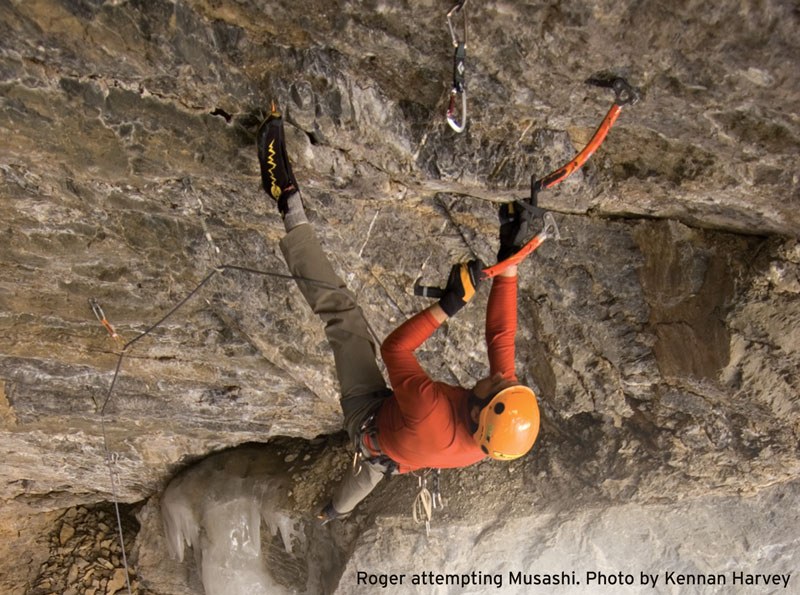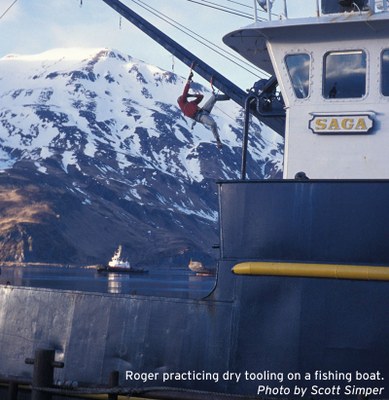
Sport climbing is predictable. In sport climbing you clip into pre-drilled bolts while climbing a rock face. Before starting up a route, you know just how long the climb is going to be, and just how many bolts you will clip as you go.
In traditional (trad) climbing, you place your own protection to save you in the event of a fall. Trad climbing is less predictable, but short of a hold breaking off or the rock becoming polished over time, rock climbs remain more or less the same from year to year.
Then there's ice climbing. In the words of Roger Strong, leading activist in modern mixed climbing, backcountry skier, and most importantly, husband and father, ice climbing is: "Always changing. You can climb a classic ice route 100 different times and it will climb 100 different ways.” To him, the appeal of ice IS its unpredictability. To me, a sport-climber whose only experience placing gear came last Christmas when I helped a friend decorate their apartment using Camalots, it all seems a little too . . . unpredictable.
An Uncommon Beginning
Roger, or Roj as he is known, began climbing at 17. He bought his first trad gear a year later after enduring a successful rookie season as an Alaskan crab fisherman. He went on to have a successful 20-year stint as Captain in the Bering Sea, and was even featured on the Deadliest Catch, Season 1. Roj credits fishing and climbing with saving him – for putting him back on the straight and narrow. As a crab-boat Captain in the Bearing Sea, he earned a living while enjoying 6-8 months a year to fully explore his outdoor potential and find his true happiness.

Roj quickly fell in love with mixed climbing, the "redheaded stepchild" of rock and ice climbing where the climber ascends routes comprised of both rock and ice using ice tools and crampons. Unlike strict ice climbing where ice screw placement is required, mixed climbs are often bolted and only occasionally require a screw or trad piece. This means the climber isn’t at risk for pulling gear on a fall – making it safer than ice climbing.
At some points in the season, mixed climbing becomes the only way to get to the top of routes. Sometimes it’s the only way to ever get to the top– the route just can’t be climbed without the ice. And this is where Roj excels. “You get to use all of these neat rock climbing skills with four sharp points on your limbs,” he says with a smile. “It’s a completely different kind of puzzle.”
Credited with establishing the first M11 route in Washington State (roughly equivalent to a 5.12+ rock rating), Roj has
put up 13 new routes in the Snoqualmie area, ranging from an M6 - M11+, and has a number of finished and un-finished routes around Mt. Baker and Mt. Index. He’s also climbed all over
the world, his favorite all-around adventure mecca being Canmore, Alberta.
To break into the sport of mixed climbing, Roger advises getting in as much ice/winter/alpine climbing as possible. “Find a partner or guide with solid experience who can mentor you, then find some crags where you can easily put up a top rope to rehearse the movement. Get familiar with using tools and crampons on the rock,” he says. When starting out it is important to leave your ego at home. “When you feel like you’re ready to lead, start with bolted routes first and stick clip the 2nd or even 3rd bolt if you can,” he says. “Falls happen more unexpectedly and it takes a lot of mileage to ‘feel’ the metal against the stone.”
And Roj is itching to get back to the stone, specifically to
his nemesis on Mt. Index’s East Face. The hardest summit to climb in Washington according to Fred Beckey, Roger has put up 22 pitches on the middle summit of the East Face, but the last two-pitches continue to elude him. He's anxious to get back out there after a few unexpected years away.
The Unexpected Challenge
Two years ago Roger was in a major avalanche. Along with 4 ski-partners, he was swept down the face of Mt. Snoqualmie and hit a tree with such force that his tibias were ripped from his femurs. He spent months in and out of surgeries, then more months in a wheelchair as he relearned to use his new legs.
Of the avalanche and ensuing recovery, he now understands "just how close you can get to giving up." He credits the outdoor community with inspiring him to keep moving, "I was completely amazed and humbled by how the entire outdoor community rallied to help my family." He said. "Everyone was there to offer support as we needed it - I will never forget that."
I asked him if any unexpected positives came out of his accident. He thought a moment, smiled, and said, "building a relationship with my daughter." Now four, Maya was 22-months old at the time of the accident. Roger's wife Merridy works full time, and Roj spent a lot of time with Maya during his recovery just hanging out and reading books. "Every day I look forward to coming home and having that kind of time with her.” He says about Maya. “When I'm out, I think about her a lot."
The Power of Unpredictable Adventure
So why continue climbing? Why keep skiing with so much at stake? Some would call him irresponsible for continuing such dangerous pursuits with so much at stake. But Roj feels alive when he's outside. Wouldn't it be MORE irresponsible to spend his remaining time miserable on the couch?
"No one was surprised as to why I was in that wheelchair,” he said. “I was there because of choices I made. And choices I continue to make." Nowadays, Roj considers Maya in every outdoor decision. This is why he continues to enjoy outdoor adventures.
"Adventure to me means getting outside of your comfort zone." He says. “I don't believe that adventure has to have risk. Getting to the top just because it's a goal does not make it a success. Adventure is successful if you get outside of your comfort zone; when you discover something unexpected about yourself, that's adventure. It's unpredictable and it can happen just a few steps outside your door."
This article originally appeared in our January/February 2014 issue of Mountaineer magazine. To view the article in magazine form and read more stories from our bi-monthly publication, click here.
 Kristina Ciari Tursi
Kristina Ciari Tursi